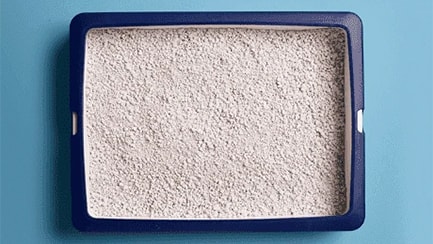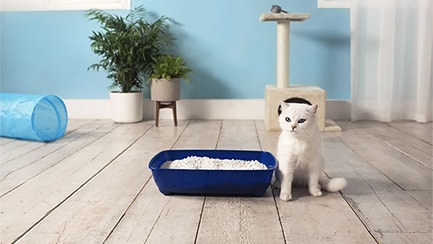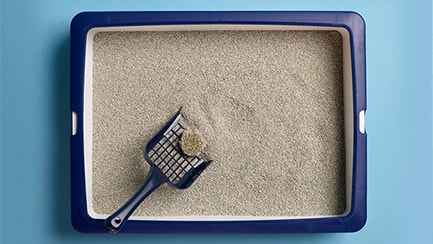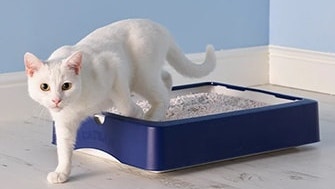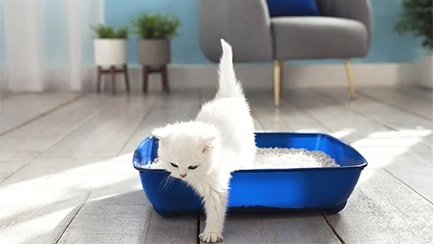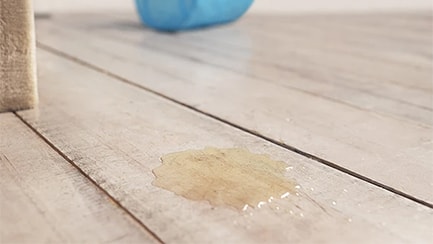FAQs
-
Do you recommend clumping or non-clumping litter?
This really comes down to what you – and perhaps more importantly your cat – prefers. The only exception to this is if you have a kitten, in which case we’d always recommend non-clumping litter. This is because kittens sometimes eat their litter (and anything else they can sink their inquisitive little teeth into!) and clumping litter could clump in their stomach.
Assuming you’ve got an adult cat, the biggest difference between clumping and non-clumping litter is the cleaning routine. Non-clumping litters, such as Catsan™ Hygiene litter, absorb a large volume of liquid. This means, as long as you remove faeces daily, the litter tray will stay fresh for approximately a week. Once a week, you’ll need to empty the litter tray completely and fill it with new litter.
Clumping litter, such as Catsan™ Ultra Plus litter or Catsan™ Natural clumping litter, forms a clump around urine or faeces so that you can easily remove that instead of having to empty the entire litter tray (don’t forget to keep the litter topped up to make up for the clumps you’ve removed). This can mean less frequent thorough cleaning, although it’s important to remember that cats are scrupulously clean and will expect their litter tray to be too!
Aside from cleaning, the other main differences a cat parent will notice is that non-clumping litter, being porous, is lighter. This is convenient when you’re out shopping, but it does mean the litter comes out of the tray slightly more easily when your cat digs. Clumping litter is heavier to carry but more likely to stay in the litter tray.
What is Catsan™ made of?
We’ve spent four decades perfecting our ‘recipes’ and are proud of the high-quality, natural ingredients we use. These vary across the range. Catsan™ Hygiene litter, for example, is made with lime and white quartz, and Catsan™ Natural litter is made with a by-product of wheat milling that would otherwise go to waste.
Want more detailed ingredient information? Just check out our product page.
Does Catsan™ contain biocides or antibacterial agents?
At Catsan™, we don’t believe in adding harsh substances such as biocides or antibacterial agents to our litters. Instead, we design them to make them as unattractive to bacteria as possible – which of course makes them very attractive to your scrupulously clean cat!
Does Catsan™ make a biodegradable or compostable litter?
Catsan™ Natural clumping litter is 100% biodegradable and 100% compostable.
Want to know more? Just check out our product page.
Is the packaging recyclable?
Almost all our products (98%) come in paper bags that you can easily just pop into your paper recycling. The only exception is the Catsan™ Smart Pack™, and we’re working hard to make sure we keep the same great product but also make sure it’s recyclable. We’re committed to do this by the end of 2025.
How easy is it to switch from my current litter to Catsan™?
As cats have such high standards of cleanliness, they’re likely to love Catsan™! However, because they’re somewhat fussy creatures who tend to get set in their ways, it’s important to make the change gradually. This means mixing in the new litter with some of the unsoiled old litter over a period of several days. This gives your feline friend time to adjust.
I’m pregnant, is it safe for me to change cat litter?
Cat faeces can be dangerous for pregnant women, so the advice from the NHS is that they should avoid changing cat litter if at all possible. If you have to do it, wear a mask and rubber gloves and wash your hands very thoroughly afterwards.
How do I dispose of litter?
The good news is, because Catsan™ litters are high-performing and long-lasting, there’s less to dispose of over time.
If you use Catsan™ Hygiene Plus litter, Catsan™ Smart Pack™ litter, Catsan™ Ultra litter, it’s best to just pop it in your regular household waste.
If you use our biodegradable litter, Catsan™ Natural clumping litter, we recommend that you put it in your communal bio waste where local regulations allow. We don’t recommend putting litter into private compost bins as these normally don’t get hot enough to kill all the possible bacteria and parasites in cat faeces.
While technically feasible, we also wouldn’t recommend flushing Catsan™ Natural Clumping litter down your toilet. This is because, just like other ‘flushable’ litters, it uses water unnecessarily and puts a strain on waste water treatment.
Where should I place the litter tray and why?
Just like humans, cats like a bit of peace and privacy when they go to the toilet, so try to place your cat’s litter tray in a quiet place. Make sure it’s not near their food or water bowl either – cats are way too clean and fussy to want to go to the toilet close to where they eat!
Finally, bear in mind that your cat’s litter tray should be easily accessible to them. If you’ve got a senior cat, for example, this could mean not putting their litter tray upstairs or in the basement so they don’t have to contend with stairs every time they need the loo.
What kind of litter trays are best?
Litter trays come in all shapes and sizes and ultimately it’s a matter of finding the one your cat likes best, but do make sure it’s big enough for them to move around freely and turn 360°. If you have a kitten or an older cat, you need to make sure the edges aren’t too high for your feline friend to easily get in and out.
Why do some litter trays have a hood?
Some cats like the privacy that a hooded litter tray affords, although others feel safer with a clear view of their surroundings and any ‘threats’.
From an owner’s point of view, a hood means you don’t have to look at the litter. It can also be useful for trapping odours and prevent your cat from scattering the litter over the floor when digging.
Do I need a litter tray if I have an outdoor cat?
Even if your cat has access to the outside world, it can be a good idea to have a litter tray in the house. This gives your cat choices and stops them ‘holding on’ because it’s pouring with rain or the neighbour’s dog is outside.
How many litter trays do I need?
Cats don’t like sharing their litter tray with other cats, which is why you should have at least one litter tray per furry friend and ideally one spare one as well.
If you have a kitten, you might want to consider having a litter tray in every room. Just like small humans, kittens can get caught up in playing and not realise they need to pee until the last minute!
I’ve heard that some cats like one litter tray to pee and another to poo. Is that true?
It can be true! If in doubt, provide your feline friend with more litter trays than you think they need.
What are the advantages of automatic cat toilets?
Automatic cat toilets can save owners hassle and time by doing the daily cleaning so you only have to empty the storage compartment about once a week (depending on capacity). As most automatic cat toilets have a hood, this, in addition to the self-cleaning cycle, can result in less dust and odours. Some cats actively dislike the noises they make though.
If you do go for an automatic cat toilet, make sure you check the user’s manual to see which litter they recommend.
What’s the best type of litter scoop?
The material, colour and shape of the scoop you use comes down to personal preference but it’s important to choose one that has the correct size of grid. It needs to be large enough to let unused litter granules pass through but small enough to hold back faeces or urine clumps.
How often should I change the litter?
Cats are very clean animals with a highly developed sense of smell so it’s important to keep things just so. Scooping the litter box at least once a day and then giving it a thorough clean and fresh litter once a week is a good guideline, but there are lots of factors to take into account. You’ll have a different cleaning routine if you use clumping or non-clumping litter, for example, and you’ll obviously need to do more litter tray changes if you have more than one cat. You might also want to change the litter more often depending on where it is in your home, particularly if it’s in your kitchen (although do bear in mind that cats have a very strong sense of smell so they’ll want a nice fresh litter tray even if it’s placed somewhere where whiffs don’t bother you as much).
Ultimately your cat’s behaviour is one of the best indicators of whether you’re cleaning the litter tray often enough. If they’re using it happily, then you’re probably getting things right.
How should I clean the litter tray and what products should I use?
Empty the litter tray and then give it a thorough wash using a mild, non-scented detergent. Avoid using any products that contain ammonia, bleach or any type of caustic ingredient.
Keeping a little bit of the unsoiled old litter and mixing this in with the new will mean the litter tray smells familiar (and therefore acceptable!) to your cat.
How much litter should I add to a tray?
Follow the instructions on the side of the pack. For Catsan™ Hygiene litter this is about 5cm and for Catsan™ Natural Clumping litter it’s about 6cm.
Of course, this is only guidance and how much litter you use is down to your cat (naturally!) and how enthusiastic they are about digging. The right amount of litter allows your cat to dig and cover which is a natural feline behaviour. If you don’t put enough litter into the tray, your cat may well refuse to use it and, if they do, urine will not be properly absorbed making it smelly. Too much litter isn’t a good idea either as it’s wasteful.
What size litter tray is ideal for kittens? What about adult cats? And what about seniors?
Your cat’s litter tray should be about one and a half times the length of the cat from its nose to the base of its tail. This means they have enough space to move around, dig and cover.
A standard box of 50 x40 cm should be fine for most adult cats then (unless they’re a Coon or another big cat) and a smaller box of 40 x 30 cm should be suitable for a kitten.
A word on senior cats: While they won’t need a different sized litter tray you should make sure the sides aren’t too high for them to get in and out easily, particularly if they have arthritis.
Can I hide the litter tray in furniture (like a cupboard with an access hole)?
Hidden litter trays are a growing trend and popular with design conscious owners. Do make sure the litter tray is still easy for your cat to access though and (as with any litter tray) make sure it’s in a quiet part of the house and not near your furry friend’s food and water.
Is it better for cats to go outside or use litter?
If you cat goes to the toilet outside, this will obviously mean less cleaning for you although the trade-off is having stinky gifts left in your garden and your neighbour’s garden!
From your cat’s perspective, going outside gives them more freedom to choose their elimination areas.
Using litter can help you to monitor your cat’s health as you’ll quickly be able to spot problems such a blood in urine or litter avoidance.
There’s also a strong argument that even a cat who has access to the outside should have a litter tray. This gives your furry friend choices and means they don’t have to venture outside if they don’t feel like it.
How can I make the litter for my cat as ‘natural’ as possible?
Some litters are made with plant based raw material, such as corn kernels, walnut shells or wood. They might be developed without any chemical odour-masking agents and be biodegradable.
All Catsan™ litters use natural raw materials and are free from artificial additives. CATSAN™ Natural Litter is a great plant-based litter which is made with a by-product of wheat milling that would otherwise go to waste. This litter naturally binds odours into clumps and is 100% biodegradable.
Whatever litter you use, it’s important to bear in mind that being able to bury their ‘gifts’ is natural behaviour for your cat! In order for them to do this, their cat parent needs to make sure there’s always enough litter in the tray. This is about 5 -7cm but it’s best to check the instructions on the side of the pack.
How can I litter train my kitten?
Most kittens will instinctively use a litter tray from a young age, particularly if they’ve seen their mum do it. (There are lots of really important reasons why kittens shouldn’t be taken from their mothers too early, and you can add this relatively minor one to that list.)
It’s important to choose a litter that’s safe for your kitten as, just like human babies, kittens tend to explore the world with their mouths. This means a non-clumping, natural litter that is less likely to be inhaled or ingested. We recommend you avoid clumping litters for your kitten as it’s more likely to clump in their tummies if they do eat it.
To train your kitten to be a litter box pro, place several litter trays around the house and make sure they’re easily accessible. Then, get into the routine of placing them in the litter box after mealtimes and naptimes (which is when they’re most likely to eliminate). If there are any accidents, don’t yell or punish your kitten as this will be counterproductive. Instead, place them in their litter tray to help them get the message for next time. Find out how to remove the cat wee smell if they do have an accident.
Why is it recommended that kittens use a litter tray and don’t go outside?
Things like traffic means the outside world can be dangerous for cats, especially kittens, and you certainly shouldn’t let your kitten go out before they have been dewormed and vaccinated. As elimination is part of marking territory, your kitten could be in contact with other cats’ waste. This won’t be a problem once your kitten’s immune defences are stronger but could cause a real issue if your kitten is allowed out too soon.
Instead, take the opportunity to get your kitten used to using the litter tray. Cats are territorial creatures and your kitten will want to find a specific place to eliminate.
What is the best litter for kittens?
For kittens, a coarse-grained non-clumping litter is recommended, such as Catsan™ Hygiene non-clumping litter. This is because it’s less likely to stick to their fur and be licked up by the kitten when they clean themselves.
Clumping litters are best avoided during the first 12 months of your kitten’s life as they may try to eat their litter. Clearly this is best avoided! However, if they do eat non-clumping litter, it’s unlikely to cause any problems and will just come out in the natural way.
Is it dangerous if my kitten eats litter?
It’s not unusual for kittens to eat their litter – and, for that matter, pretty much anything they can find!
For this reason, it’s important to choose a litter that’s unlikely to cause any serious issues if eaten. This means a non-clumping litter because clumps that form in the stomach can cause an intestinal blockage. You’ll also want a non-toxic type of litter made of natural substances, without any chemical odour-masking agents and fragrances. Catsan™ Hygiene non-clumping litter ticks all these boxes.
If your kitten does eat a large volume of litter (even if it’s the ‘right’ type) and you are in any way concerned about them, don’t hesitate to get them checked over by your vet. Eating litter can be a sign of malnourishment or other medical conditions.
What size litter tray is best for kittens?
The guideline for the size of a litter box is: one and a half times the length of the cat from its nose to the base of its tail. For your kitten, this will probably mean a box about 40 x 30cm. This will give your furry friend the opportunity to move around, dig and cover. Make sure the sides aren’t too high either. Your kitten needs to be able to get in and out easily.
Do you recommend clumping or non-clumping litter for kittens?
Until a kitten is 12 months old, we recommend non-clumping litter, such as such as Catsan™ Hygiene non-clumping litter. This is because clumping litters can be dangerous if they are eaten and this is something that young kittens are prone to do. Ingesting clumping litter can cause intestinal blockages which is an emergency and requires immediate vet attention.
Do you recommend coarse or fine-grained litter for kittens?
For kittens under 12 months old it best to opt for a coarse-grained, non-clumping litter. Fine granules are more likely to stick to their fur and get ingested when they clean themselves. It’s also not unusual for inquisitive kittens to eat their litter (or pretty much anything else!) and a coarse-grained, non-clumping litter is less likely to cause problems.
At what age can a kitten be separated from their mother? What is the mother’s role in litter behaviour?
Kittens should not be separated from their mothers until they are at least eight weeks old, and preferably 10 -12 weeks old.
When they are first born kittens can’t eliminate on their own and need their mums to stimulate excretion by licking them.
As kittens get older, their mums are pivotal in teaching their babies to use the litter box and most kittens are very happy to mimic what they see.
Do kittens pee more than adult cats?
It is true that a kitten’s metabolism is different to an adult cat’s (just like a human baby is very different to a human adult). However, if your kitten starts peeing a lot more than normal or having lots of accidents, it might be that they have a urinary tract problem or some other medical issue. If you’re at all concerned, talk to your vet.
My cat refuses to use the litter tray. Why is that?
There are a number of reasons why your feline friend might not use their litter tray. It could be an issue with the litter tray itself. Maybe it’s too small, difficult to access or in a location that’s too busy or too close to your cat’s food? Or maybe something scared your cat while they were trying to use the litter tray? This could anything from the washing machine hitting its spin cycle to someone playing an instrument in the same room.
The other thing which will put a cat off its litter box is if it’s a bit whiffy – cats are very clean.
If none of these things are the problem, you need to think about what might have affected your cat’s behaviour. Has there been a house move, a new pet or a new family member? Unneutered male cats might be marking their territory and non-spray marking can also lead to elimination outside of the litter box.
Sometimes a cat not using their litter tray can be a sign of a health problem such as bladder discomfort, urinary tract problems or digestive issues. So when you’re cleaning up after an accident, use a white tissue and be on the lookout for tell-tale red dots of blood in the urine (this is one of the reasons we make Catsan™ Hygiene litter white). If you suspect there is a health problem, don’t hesitate to talk to your vet.
Why does my cat eliminate outside the litter tray?
Cats are very clean so if they’re weeing or pooing outside their litter tray, it could well be because their litter tray isn’t clean enough for them. Once you know it meets your cat’s exacting standards, think about other things that might be putting your cat off. Is the litter tray positioned somewhere too busy? Is it too small for your cat to turn around in and dig? Have you recently changed your cat litter?
Once you’ve ruled out all these issues, the next step is to take your cat to the vet to make sure your cat isn’t territory marking or suffering from a health problem (arthritis, for example, could make it trickly for your cat to get in and out of their litter tray).
How can I teach my cat to use the litter tray?
If you’ve only recently got your kitten or cat and they don’t yet know how to use a litter tray, you’ll need to show them how. The best way to do this is to establish a routine where you set your feline friend in the litter tray immediately after mealtimes or after waking up from a nap. They’ll soon get the idea and, in the meantime, if there are any ‘accidents’ along the way, don’t yell or punish your cat – they respond much better to positive encouragement.
How do I teach an outdoor cat to use the litter tray?
Sometimes you need to teach a cat who has always gone to the toilet outside how to use a litter box. As well as following the tips above, it’s worth picking up one of your cat’s ‘gifts’ from the garden (make sure it’s definitely from your cat!) and placing it in the litter box – your cat will quickly get the hint. In fact, the whole housetraining process is likely to be a speedy one. Cats far outshine their doggy counterparts in this area!
We moved to a new house and now my cat refuses the litter tray. What should I do?
Moving can be stressful for pets in the same way it is for humans so, if you’ve only just moved, there might be a few accidents. Make sure your cat’s litter tray is positioned somewhere quiet and private and not near their food and water bowls. You could try placing it where any ‘accidents’ occurred – after all, that’s your cat showing you where they’re happy to eliminate! It’s also important to keep the litter tray scrupulously clean.
How do I train my cat to stop urine marking?
Territory marking is common in unneutered male cats and neutering is usually the solution. But urine marking can also sometimes be an issue with a neutered cat. If this is the case it’s a good idea to chat to your vet about probable causes and solutions.
Why is my cat sleeping in their litter tray?
If you have a kitten who likes to nap in their litter tray, the most likely explanation is they just haven’t quite worked out what’s what yet. However, if you have an adult cat who has suddenly started sleeping in their litter tray, this could be because of an underlying medical problem, such as a urinary infection, kidney stones or diabetes. So it’s important to get your cat checked out by the vet. If medical problems have been ruled out, the issue is a behavioural one and suggests your cat is feeling territorial or stressed. Have you recently adopted your cat? Are there other animals in the house that might seem like a threat?
Why do cats dig in the litter?
Digging is a natural feline instinct, and cats are hard-wired to want to bury their ‘gifts’! That said, if you cat suddenly starts digging excessively, it could be because of a physical problem, such as digestive trouble, or an emotional problem, such as stress. See the vet to rule out the first and then, if no medical issue is found, do your best to mitigate the second.
My cat eats their litter. Why and is it dangerous?
There are lots of different reasons why your furry friend might eat their litter. A kitten is probably just doing it out of curiosity whereas an older cat might be doing it because they have a mineral deficiency or some other health issue. To rule these out, it’s best to get your cat checked out by the vet.
In terms of whether or not eating litter is dangerous, it very much depends on what type of litter it is. A clumping litter can cause an intestinal obstruction (because it may clump in the stomach) which won’t happen with a non-clumping litter. That said, it’s probably best if your cat doesn’t eat huge quantities of any litter – there are lots of tastier options!
What can litter tray behaviour tell me about the health of my cat?
Litter tray behaviour is a good indicator of your cat’s health. If your cat goes in, digs, eliminates and then covers urine and faeces, it’s a sign they’re in good health. Conversely, cats who suddenly stop using their litter tray may have a medical problem (unless they have an issue with the litter or litter tray itself, such as it being placed too close to their food bowl). If your cat was using their litter tray happily and stops doing that, it’s always worth talking to your vet.
Can cats be allergic to certain litter products/dust?
Kittens, elderly cats or cats with weakened immune systems are more likely than others to develop allergies. The symptoms vary but typically include sneezing, a cough, dry eyes and vomiting.
There are several different litter tray issues that could trigger an allergic reaction, from litter dust, to scent, to the plastic the tray itself is made from.
If your cat is allergic or has a high respiratory sensitivity, you should use a dust-free, unscented litter.
Popular articles

